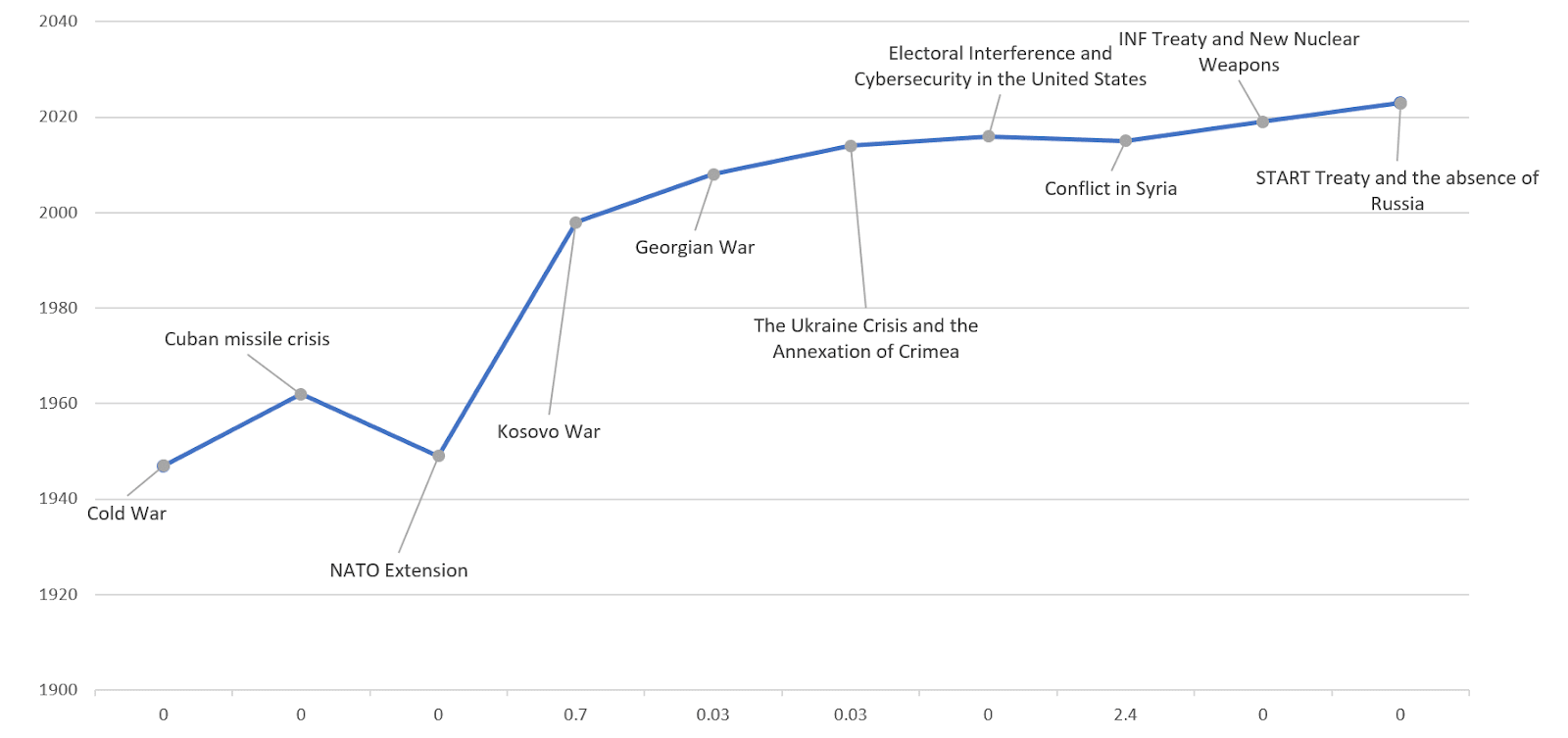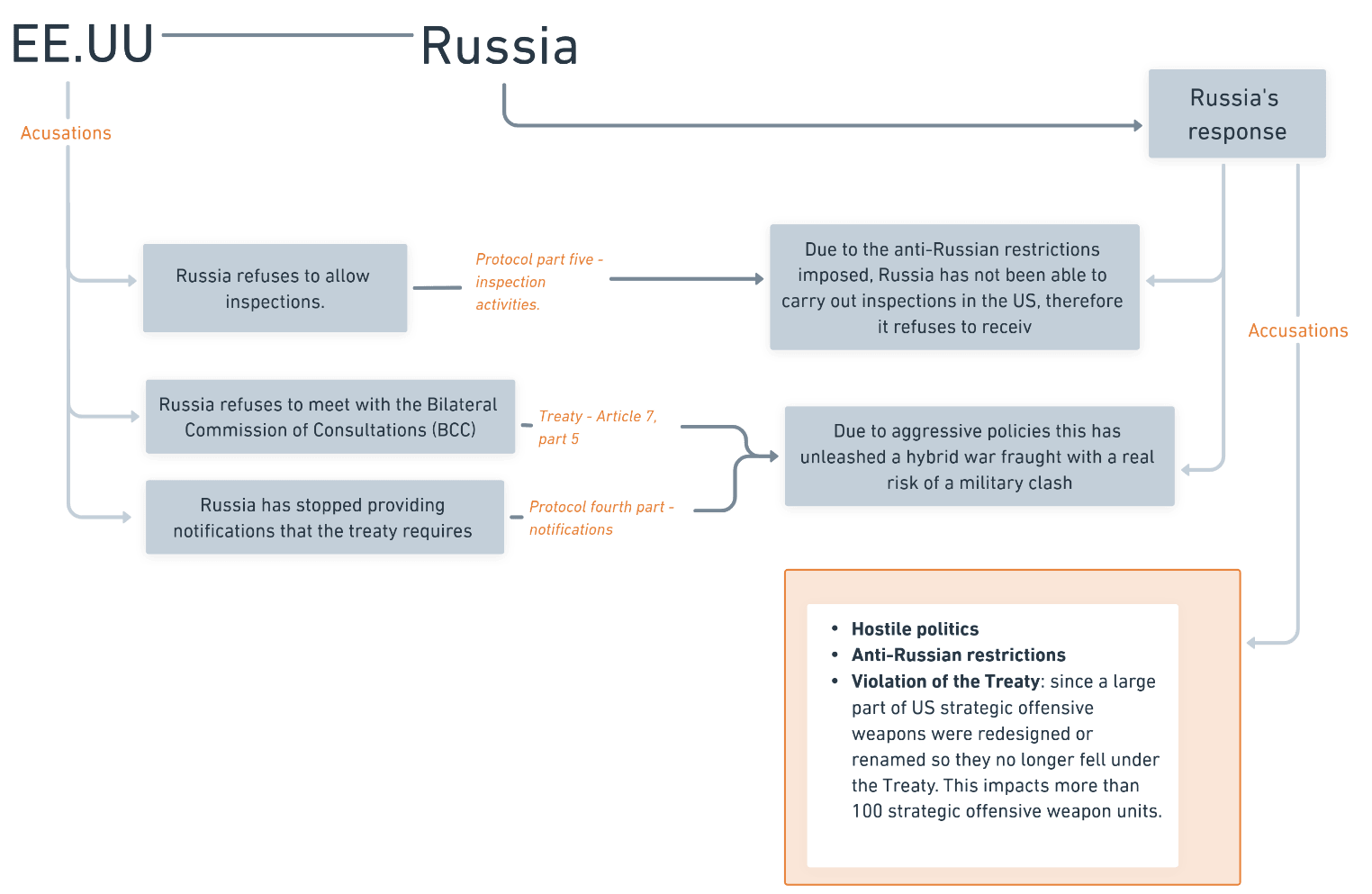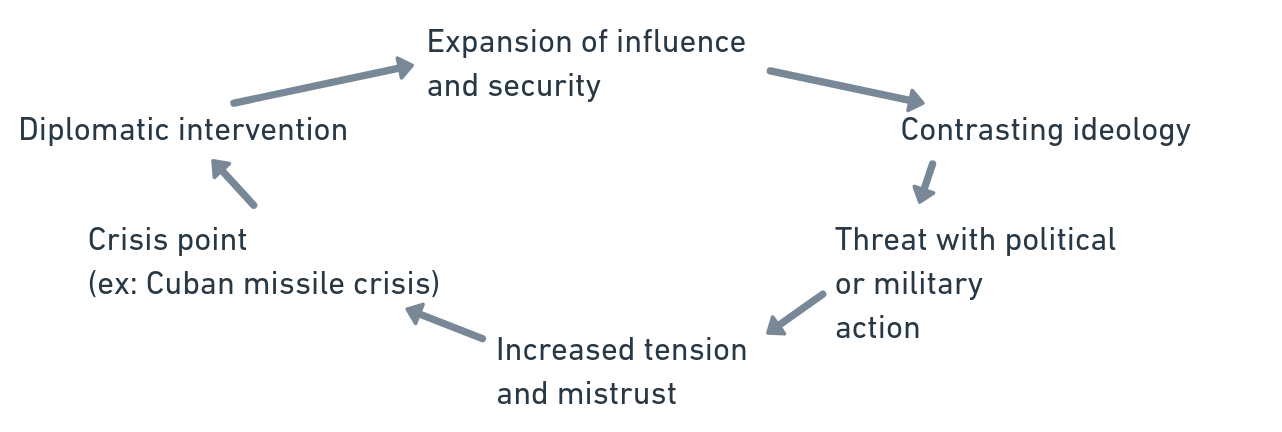“This project was carried out as part of the Carreras con Impacto program during the mentorship phase. You can find more information about the program in this entry”
Complete investigationProject overview
Russia has indicated its intention to withdraw from the Strategic Arms Reduction Treaty (START) III, and on March 15, 2023, the United States accused Russia of failing to meet its obligations under the treaty, escalating tensions in nuclear arms control.
The study considers the arguments and objections of both parties, highlighting that the conflict goes beyond the treaty and reflects persistent historical behaviors since the Cold War. A systematic analysis reveals a pattern of six phases in their conflicts: expansion of influence and security, opposing ideologies, political or military threats, increased tension and distrust, crisis points, and diplomatic interventions. As a consequence of so many tensions, including this one, Russia indicates that the United States has unleashed a hybrid war fraught with the real risk of a military clash between two nuclear powers. Five alternatives are proposed, considering their potential failures, based on the models of Allison T. Graham in "Essence of Decision: Explaining the Cuban Missile Crisis". It is concluded that if timely actions are not taken, Russia might withdraw from the START treaty by 2026, thereby increasing a history of distrust and further diplomatic tensions that could end in a military confrontation.
The importance of this research
Due to the negative effects and historical record of nuclear armament, I was motivated to analyze the various consequences of this decision and propose some alternatives that could enhance collaboration and reduce the use of strategic weapons, thus disseminating proposals for cooperation. Additionally, this research represents a significant milestone as an international business student, allowing me to acquire and practice skills related to my area of expertise, focused on a priority cause. I hope it can inspire more people in this field and related areas to take action in favor of resolving the conflict.
Research goal
The main goal of the research is to analyze the geopolitical implications and current strategies arising from the conflict between Russia and the United States in the context of the START III treaty, evaluating the consequences of a possible Russian withdrawal, and proposing bilateral collaboration alternatives to enhance international security.
Methodology summary: To identify the root of the issue, an analysis of the new START treaty, its policies, and the diplomatic agreements made by both nations was conducted, alongside an examination of the factors contributing to nuclear tensions and the reasons behind Russia’s withdrawal from the agreed-upon stipulations. This investigation took almost four months to analice and involves the use of tools such as documentary research and data analysis. Based on the collected information, five alternatives were developed to improve relations concerning the new START treaty.
Theoretical framework
Note: This is a long post. For those who are only interested in a particular question, you can go to the section or chapter of your interest below. Chapter 1 and 1.1 can be skipped. Chapter 2 covers the conflict and it is important for your understanding of this research. Chapter 3 includes the alternatives proposed, section 3.2 can be skipped if you are not interested in the possible outcomes of the proposed options.
Chapter 1. Historical context
1.1. Historical context of Russia and the United States
It is known that Russia and the United States are powers whose differences are not something of the 21st century. We can say that it all began with the start of the Cold War in 1947. To know more about historical context, please refer to the attached document.
Figure 1. [Timeline]. This figure marks the evolution of the conflicts between the United States and Russia that have lasted more than 70 years and is expected to increase. The “X” axis represents the number of deaths in percentage of each conflict, having a scale from 0% to 3%, while the “Y” axis represents the year of the event.
Chapter 2: Current analysis in relation to the START III treaty
2.1 What are the current measures of the START treaty for strategic weapons?
The START treaty was signed by the United States and the Russian Federation and remains in effect until February 4, 2026. Despite being extended until 2026, both nations agreed to make adjustments regarding the measures and limitations of the agreement according to a report by the U.S. Department of State. (U.S. Department of State, S.F).
The new updates on treaty stipulates that only 700 intercontinental ballistic missiles (ICBMs), submarine-launched ballistic missiles (SLBMs), and heavy bombers equipped with nuclear armaments are allowed; a maximum of 1,550 nuclear warheads on these deployed missiles and bombers; and no more than 800 missile launchers and nuclear-armed bombers, both deployed and non-deployed. The new verification measures focus on warheads on specific strategic launch vehicles, the biannual exchange of data, and telemetry information to monitor missile performance during ICBM and SLBM flight tests.
2.2 Why is Russia no longer interested in participating in the START III treaty?
On March 15, 2023 The U.S. Department of State announced that Russia violated certain important points of the treaty. These include the following:
- Russia refuses to allow inspections. (The treaty requires each Party to accept 18 inspections per year).
- Russia refuses to meet with the treaty's implementation body, the Bilateral Consultative Commission (BCC), which is stipulated in the treaty for both parties to meet.
- Russia has stopped providing the notifications required by the treaty. The treaty establishes that each party must provide data and notifications, including the status and movement of their nuclear forces, which they are obliged to account for.
"Fact: Russia's war in Ukraine does not provide a valid basis for Russia's non-compliance with the New START Treaty" (U.S. Department of State, 2023).
Each statement is based on established agreements. Now, before drawing conclusions and opinions, I wondered, what has been Russia's response? By August 2, 2023, the Ministry of Foreign Affairs of the Russian Federation claimed that the approach with which the START treaty was signed aimed to strengthen a new strategic relationship based on mutual trust, transparency, predictability, and cooperation, which is precisely what the United States defends in its statement. However, Russia argues that there is a discrepancy between what was established in the treaty and its objective.
“Before accusing the Russian Federation of non-compliance with the provisions of the New START Treaty, the United States should settle years-long problems with the US’s illegitimate exclusion from the counting rules of a substantial part of its strategic offensive arms, which Washington claimed to have converted or which it renamed so that they were no longer covered by the treaty terms and definition. This has to do with over 100 strategic offensive systems, a matter that is extremely important in the context of the treaty, which specified the balance of such armaments to within one weapon.”
“Regarding the suspension of inspection activities under the treaty, we would like to note that it was the US activities that violated the standard inspection procedures. Washington adopted anti-Russia restrictions, which prevented the Russian Federation from holding unobstructed inspections in the territory of the United States and thereby created obvious unilateral advantages for the American party.” (Ministry of Foreign Affairs of the Russian Federation, 2023)
As a result of all this, I began to investigate whether there is really something wrong within the treaty, since Russia's complaints are not directly related to the treaty itself. They claim they will not comply with it until the United States updates or removes certain anti-Russian policies. So, is it really necessary to update the treaty? Or do these issues and accusations stem from previous political conflicts in the bilateral relationship between both countries? Could it be that the United States is addressing them in an anti-Russian manner? Certainly, answering these questions and determining whether the accusations from both countries are valid requires a deeper investigation, perhaps going back to the past to the root of this discord between the two nations. This is why I decided to research the background. When did this dissatisfaction truly begin?
2.3. What are the possible consequences of Russia's withdrawal from the START III treaty?
It can be noted that the main dissatisfaction is not with the treaty itself, or what it entails, but rather with a series of behaviors from the parties that reflect past customs. Taking this into account, it is beneficial to analyze it in a more systematic manner. Therefore, I will take as a starting point the three main accusations from the United States and the responses from Russia.
The interesting aspect of this issue is that Russia still intends to continue participating, as mentioned by the Ministry of Foreign Affairs in 2023. However, this is somewhat contradictory, as it also states the following:
“The U.S. has unleashed a total hybrid war against Russia, fraught with the real risk of a military clash between the two nuclear powers.”
As a commitment to international security, they endorse a war between powers with a possible military clash, which leaves a lot to the imagination. The concerning part is their insistence that there is no alternative for structuring their relations based on the different principles of equality and consideration of interests.
From what I could identify, each intervention or conflict between these two powers goes through six phases before it can conclude and reach any agreement, understanding, or even a sanction. I will use these phases, focusing solely on the breaking points and competition of the nations, which, in my view, are always present in each disagreement, starting firts with expansion of influence and security:
For this analysis, I referenced the research conducted by David Peter Stroh on "A Systematic View of the Israeli-Palestinian Conflict" (Stroh, 2023). Although these conflicts are quite distant, the author's development and systematic analysis provide a highly effective methodology for analyzing and better addressing conflicts.
Chapter 3. Exploring alternatives to Russia's absence
3.1 What options remain to facilitate a fair agreement between these powers?
Took has referenced the models of Allison T. Graham in his book ‘Essence of Decision: Explaining the Cuban Missile Crisis’ to address some resolutions to the conflict, although I will only be using two of these models.
- Rational Actor Model (RAM): Use this model due to the focus on the shared interest both countries have in the national security of their territories and its enhancement. Although both countries may not yet perceive the current risk of their actions regarding the treaty, I will use this model considering the MAD (Mutual Assured Destruction) doctrine. The destruction of their territories due to inadequate implementation of inspections would be quite extreme, wouldn't it?
- Organizational Behavior Model: Use this model because, rather than focusing on a cost-benefit analysis for the nations in question, decide to base the alternative on the organizational culture that has been used in past tensions.
Alternatives: Without resorting solely to direct negotiations.
- The U.S. should visibly demonstrate a reduction in its military threats so that Russia feels less need to increase its arsenal.
- Promote arms control initiatives through international organizations like the UN or multilateral forums excluding temporarily the U.S., so Russia can show its participation and commitment.
- The U.S. should adopt or modify internal procedures and implement audits of its inspections and inspectors, thus impacting the treaty's implementation context indirectly without direct interaction with Russia.
- The U.S. should avoid public or direct contact with Russia and instead wait for a third party, like the UN or the international community, to hold both parties accountable for their actions without favoring either side.
When communicating regarding the U.S., Russia should maintain more direct contact without intermediaries, involving only presidents and international representatives to seek better transparency. (Similar to what occurred in 1986 in Geneva, where President Ronald Reagan and General Secretary of the Soviet Union Mikhail Gorbachev organized a meeting that did not result in any agreements but provided an opportunity for Reagan and Gorbachev to assess each other and express their differences).
3.2.Failure Modes and Possible Outcomes
Failure Modes (Alternative 1): Russia or its allies might perceive the reduction of threats as a sign of weakness, potentially causing the opposite effect by encouraging Russia to increase its influence or take advantage of the situation. Additionally, Russia might distrust the authenticity of the reduction, considering it a tactical maneuver.
Possible Outcomes: This could lead to decreased tensions and a lower likelihood of nuclear escalation, while also enhancing the image of the U.S. as a nation willing to take steps to reduce tensions.
Failure Modes (Alternative 2): International organizations might struggle to reach a consensus on how to address the situation, especially if some members have divergent interests. Furthermore, the initiatives might not have a significant impact without the active participation of the U.S.
Possible Outcomes: This could strengthen the role of international organizations in arms regulation, promoting global cooperation. It might also increase pressure on Russia to engage in arms reduction, given the international support.
Failure Modes (Alternative 3): The changes may not be sufficiently visible or transparent to influence Russia's perception, and internal changes might not directly impact relations with Russia if not communicated effectively.
Possible Outcomes: This could improve transparency in the inspection process, potentially increasing trust and interest in U.S. commitments.
Failure Modes (Alternative 4): The diffuse responsibility between the UN and the international community might dilute the effectiveness of actions and could be perceived as inaction or evasion of responsibility by the U.S.
Possible Outcomes: This could lead to more balanced international pressure on both parties to comply with their commitments. By avoiding direct contact, it could foster the idea of shared international responsibility in arms control.
Failure Modes (Alternative 5): This might create excessive rigidity in communication, limiting the ability to quickly address emergencies or crises.
Possible Outcomes: This could increase clarity and accountability in negotiations by involving the primary decision-makers directly, potentially allowing for quicker decision-making in critical matters.
Conclusions
The new START treaty will be in effect until 2026. If timely actions are not taken, there could be a possible withdrawal of Russia from the START III treaty. Russia's refusal to allow inspections and to meet with the Bilateral Consultative Commission, combined with the cessation of notifications about the movement of its nuclear forces, is really based on its reasons but somewhat immature in my opinion given the danger that a nuclear weapon represents. Additionally, Russia's absence from the treaty could complicate international relations and strengthen the perception of a "hybrid war" between nuclear powers.
The project concludes that the current tensions between the United States and Russia, reflected in the controversy over the START III treaty, are a continuation of a long history of distrust and geopolitical competition.
Limitations: The main limitation lies in the lack of information to verify the accuracy of the facts. Specifically, it was not possible to verify how the last inspection of the U.S. was conducted, so it is unknown what attitudes were taken by both parties. However, this highlighted the need to consider an audit-based alternative. Nevertheless, unanswered questions remain, such as: How did the U.S. receive Russia during the last inspection? What protocols or behaviors indicated an anti-Russian stance? Can the suggested alternatives and proposals truly contribute to an improvement? Has any international meeting or dialogue been convened to address this crisis?
Outlook: It is hoped that the project can continue to address the outstanding questions and provide more information about the START treaty, including how the non-renewal of the treaty would affect the situation, the possible use of nuclear weapons in diplomatic conflicts, and how these treaties can benefit society.
Main references:
- US Department of State (March 15, 2023). Russia's non-compliance and invalid suspension of the New START Treaty. USA. DOI: https://www.state.gov/russian-noncompliance-with-and-invalid-suspension-of-the-new-start-treaty/
- US Department of State (s.f.). New START treaty. Washington, DC. DOI: https://www.state.gov/new-start/
- Ministry of Foreign Affairs of the Russian Federation. (2023). Statement by the Russian MFA on the situation regarding the Treaty on Measures for the Further Reduction and Limitation of Strategic Offensive Arms (New START). Moscow. DOI: https://mid.ru/en/foreign_policy/news/1852877/
- Allison, G. T., & Zelikow, P. (1999). Essence of decision: Explaining the Cuban missile crisis (2nd ed.). Longman.
- Stroh, P. D. (2023). A SYSTEMIC VIEW OF THE ISRAELI-PALESTINIAN CONFLICT. The Systems Thinker. doi:https://thesystemsthinker.com/a-systemic-view-of-the-israeli-palestinian-conflict/




Executive summary: Russia's potential withdrawal from the START III treaty by 2026 could escalate tensions and increase the risk of military confrontation between nuclear powers, necessitating diplomatic interventions and alternative approaches to enhance international security.
Key points:
This comment was auto-generated by the EA Forum Team. Feel free to point out issues with this summary by replying to the comment, and contact us if you have feedback.